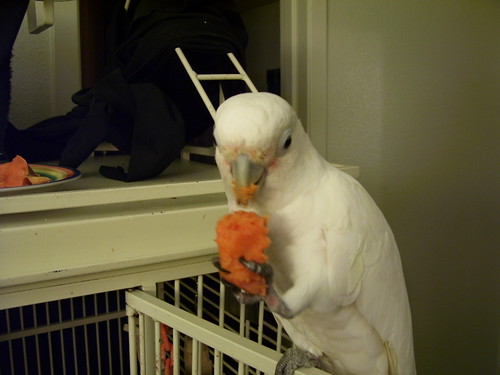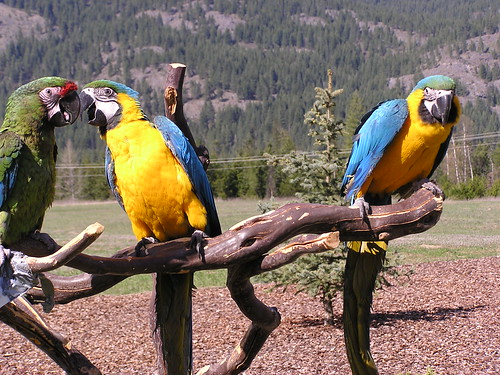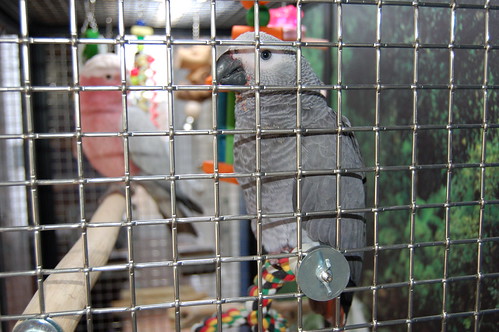I brag about Theo, my goffins cockatoo, all the time. She is so darn cute, it’s really hard not to. I took a picture of her for my friends on a parrot talk forum with sweet potato all over her beak – always good for a laugh. When I enlarged the photo, I noticed a sore on her foot. I posted the photo, but the focus was now on her feet.

The sore is the red spot below her back two toes, before the joint.
I felt pretty sure it was a pressure sore, caused by improper perching, but wanted reassurance from people with more experience in that area than I had. We all agreed that it was a pressure sore. The question was: how did she get it? She had been in the same cage, with the same configuration of perches for a year without any problem. What had changed? The answer came to me when I was cleaning her cage the next day.
Though Theo has many perches of varying thicknesses and materials, I was aware that her perching preference was in the center of her main perch, the one the runs the length of her cage. I knew this because this was the area where most of her poop accumulated.
That’s where she spent her time while preening, and apparently where she slept at night. Now her poop was now over at the right side of her cage.
Since her main perch varies in diameter, being much thicker on the one end nearest the mirror, I took the perch out and flipped it around so that the thinner end was on the side of the cage she seemed to prefer. This made the difference in her grip on the perch and the sore on her foot disappeared.

Plastic perch with sandy texture.
A bird’s feet should wrap about 3/4 of the way around their perch in order to get a good grip and maintain balance. If the perch is too large, the bird will be unstable and the constant shifting and wobbling will eventually cause skin irritation and pressure sores. There is also the danger of falling while asleep. You may find it necessary to experiment with size to find what your bird’s preferences and needs are.
Varying diameters in the perches will help your birds avert such problems as arthritis and atrophy and strengthen and increase dexterity in the feet. Your parrot will be standing on her feet 24/7 for the entirety of her life and her foot health is essential.

Manzanita perch with sandy texture on the sides.
Perches are available in a variety of materials. There are pros and cons to most of them.

Manzanita
Natural wood branches are the best way to go for your parrots main perch. Birds in the wild live in trees that have varying texture, hardness and width in their branches. The best branches you will find for your parrot at home will bend and twist in shape and have off shoots.
Aside from being the natural choice, they are also really fun to chew! A friend of mine has an amazon that had branch perch about 18″ long that was anchored to only one side of the cage. Her silly parrot would stand on the unanchored side and chew through the branch and, of course fall to the bottom of the cage. She repeats this process every time the perch is replaced.
Either she’s not the smartest bird in town or it’s a game. You can’t put a price on that kind of fun.
I do not recommend wooden dowel perches because of their uniformity in size and shape. They do nothing to exercise the feet and are also rather slippery and easy to fall from. I have to use one during part of the year for Linus, my umbrella cockatoo, because of the corn-like growths that he gets on his toes that make perching on a thicker branch uncomfortable for him at times. As soon as the growths are gone, I replace his natural perch.
***edit from original blog article*** We also no longer recommend using cement perches. Recently it was brought to our attention that some of these perches are testing posistive for lead. This can not only cause metal toxicity if chewed on but once the concrete is swallowed it needs medical intervention for removal, as a parrot can not pass it on its own. A good alternative to concrete for toe nail trimming are the sandy perches described below with a base of plastic or wood underneath the sand.
Sandy perches come in a fun variety of shapes, sizes and colors. These will help keep nails trimmed and help stimulate blood flow in the feet. However, they aren’t meant for long term perching as the course texture will irritate their skin after too long. These are great perches for food bowl areas.

Dragonwood perch and rope perch
Rope and natural fiber perches are great for comfortable relief from the harder perches. Some older, arthritic birds or those with handicaps might really appreciate them. However, since they are so soft, they invite chewing, and can get very frayed. These frayed parts can easily trap toes and nails.
I know of several instances where a nail has been ripped from its bed by a bird in a frantic effort to escape being caught the fray and one circumstance where a toe was lost. Keep the fray trimmed down with scissors whenever there is any hanging off.
Be aware if there is any chance your bird is tearing these softer perches and ingesting the strings as this can cause a crop impaction, which can be life threatening. These should not be used with birds that have made this a habit.
Shelf perches are just the greatest. I put a corner shelf in Linus’ cage and he just loves it. It gives his feet a chance to stretch and it is a great platform for toy play and eating. They are super easy to install and clean.
When you buy a perch (or borrow one from a parrot safe non-toxic tree) you will need to sterilize it before putting it into the cage. Make sure any branches you bring in from outside have come from trees that have not been exposed to pesticides. Fill your bathtub with water, add a cup of bleach and soak overnight. In the morning, rinse the perch and tub with clean water and soak the branch for another hour to thoroughly remove any traces of bleach.
I let mine dry till the next day – wood is porous and can harbor bacteria especially when wet. Perches of any material will need to be removed and scrubbed down any time there is food or fecal matter stuck to them, which will be often. Try to select perches that will make this job easiest for you.
Patty Jourgensen specializes in avian health, behavior and nutrition and has been working with and caring for rescue birds since 1987.



6 comments
This was such a refreshing and informative read! I never realized how important perch variety is for both foot health and behavioral enrichment in parrots. The comparison between wood, rope, and natural branch textures really helped me see what I’ve been missing in my current setup. As someone working with bird nutrition in India, I’ve often seen how small changes — whether in perches or diet — can drastically improve the well-being of parrots and budgies. Thank you for spotlighting this often-overlooked topic with such clarity. Subscribed and looking forward to learning more from your team!
I just adopted my aunt’s 32 yo African Grey. My aunt didn’t have a lot of money. I’m curious how many different size perches I need inside her enclosure? Also, she has been feeding her Walmart food for 8 years. Can I just get the new stuff and trash the old??? Could you also tell me the appropriate sizes of the perches I should have? Thank you!!!
Is it the arthritis that causes the bumble foot or the bumble foot that causes the arthritis. Is it because I haven’t disinfected their cage as well as I should have early on. I wonder if this is what caused it or allowed it to go untreated. Why didn’t I fix it sooner.
Offering various types of perches ensures their comfort and well-being. Different textures and diameters provide essential foot exercise and prevent discomfort or injury. Rope perches promote balance and strengthen leg muscles, while natural wood perches mimic their natural habitat. Don’t forget about heated perches during colder months, offering warmth and comfort. Give your feathered friend the best perch options for a healthy and happy life! 🦜✨ You can learn why you should give cucumber to parrots here https://avihouse.com/can-parakeets-eat-cucumber-7-astonishing-benefits/
I have a 42 year old double yellow head parrot. He has arthritis. His is grip is not as strong. I have tried the rope as well as the flat perches for him to rest. He is so stubborn when you put new things in his cage. He will not have anything to do with them. Any suggestions.
I had not thought about stretching the feet flat on my new birds when buying accessories for the 2 new cages. I can see future issues with arthritis from continual various round perch use. What size shelf perch would you recommend for a Macaw & an African Grey?
Leave a comment